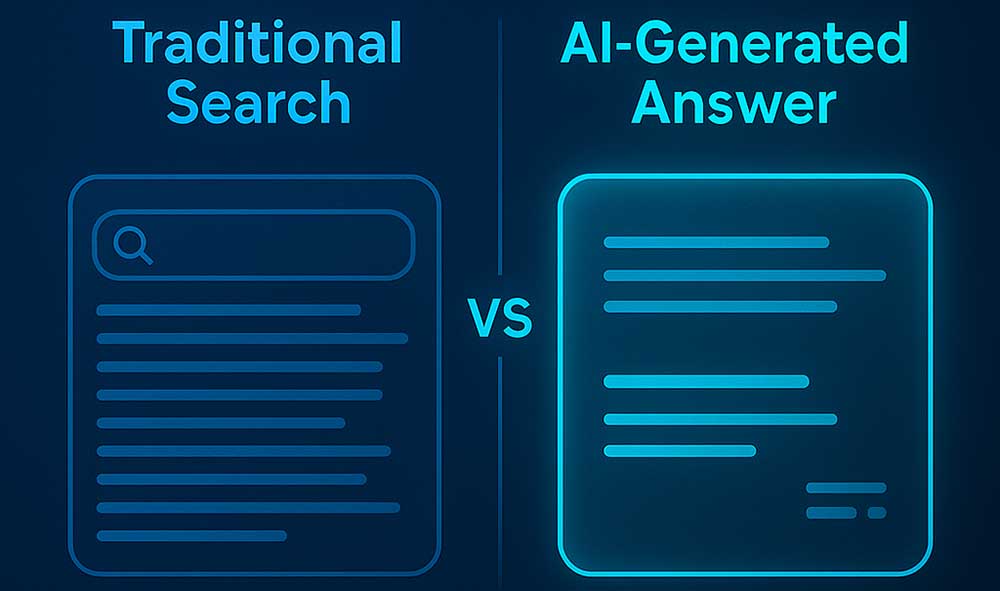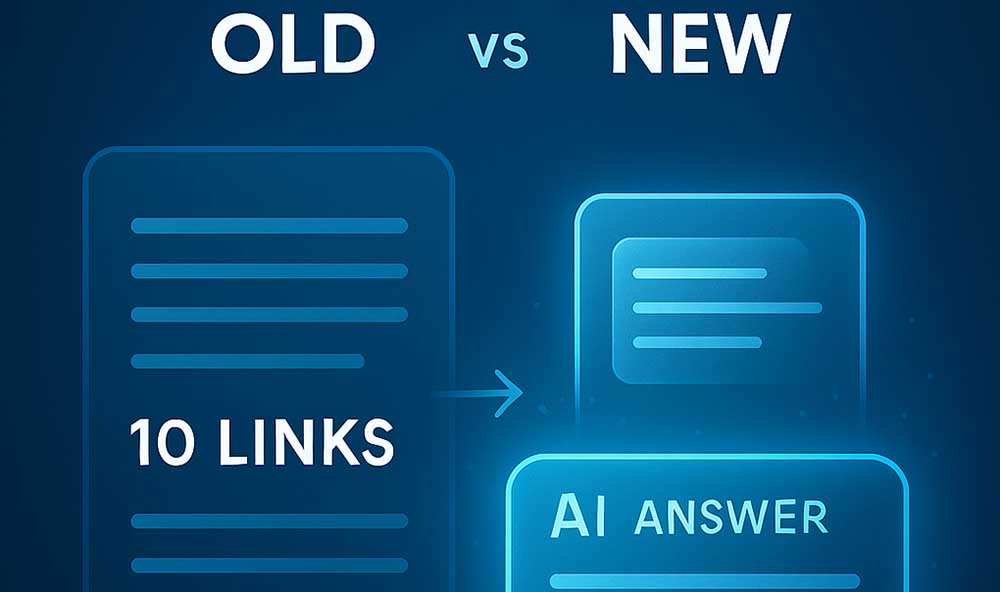If you’ve noticed traffic and enquiries slipping, even though your rankings haven’t changed, you’re not imagining it.
Search behaviour has shifted. Increasingly, people are obtaining answers directly from AI platforms such as Gemini, Copilot, and ChatGPT. They aren’t clicking through to page two of Google. In many cases, they’re not clicking at all.
That’s where Generative Engine Optimisation (GEO) comes in. GEO is about making sure your business isn’t invisible in this new landscape. Instead of just ranking, you need to be named.
What This Guide Covers
- What GEO really means — in plain English.
- How it differs from traditional SEO.
- The six-step GEO checklist (with quick wins + pro moves).
- A case study of GEO in action.
- How to measure impact and adapt as search evolves.
- FAQs every business asks about GEO.
By the end, you’ll know not just what GEO is, but how to start applying it today, whether you’re new to SEO or have been in the trenches for years.
1. GEO in Plain English: What It Is and Why It Matters
Put simply, Generative Engine Optimisation (GEO) is the process of making your business visible in AI-generated answers.
Where SEO focuses on ranking pages in search engine results, GEO makes sure AI tools can understand, trust, and recommend your brand in the answers they generate.
Think of the difference like this:
- SEO = You want to be clickable.
- GEO = You want to be quotable.
Why GEO Matters Now
- AI-driven search behaviour is rising fast — Millions of users are already typing questions into AI tools instead of Google.
- Answers-first results — Generative engines summarise, recommend, and decide who gets mentioned.
- Future-proofing visibility — Businesses optimising for GEO now are building resilience for the next decade of search.
- Local AI search is emerging — AI assistants are increasingly recommending local services, but only if those businesses are GEO-ready.
For a more comprehensive view, consider our GEO optimisation process, which outlines how Digital Hype delivers entity optimisation, content structuring, and AI search audits.
2. GEO vs Traditional SEO: What’s the Difference?

A lot of people ask: “Is GEO just another buzzword?” The short answer is no.
It’s an extension of SEO, not a replacement.
Here’s a clear comparison to show the shift:
| Aspect | Traditional SEO | GEO (Generative Engine Optimisation) |
| Objective | Rank pages on SERPs | Be named in AI-generated answers |
| Signals | Keywords, backlinks, technical health | Brand mentions, citations, entity clarity, structured content |
| Content | Landing pages, blogs | FAQs, checklists, entity-rich definitions, conversational copy |
| Authority | PageRank, domain metrics | Topic depth, author E-E-A-T, credibility signals |
| Engagement | Click-through rates | Multi-channel signals (LinkedIn posts, reviews, citations) |
| Visibility | Appearing in top 10 | Appearing in the answer itself |
**If you’re already building a strong SEO foundation, GEO is the natural next step.
For more context, see our AI SEO page, which explains how AI-driven platforms are reshaping visibility beyond traditional search.
3. The Six-Step GEO Checklist

Think of GEO as reputation management for the AI era. You’re not just trying to rank anymore; you’re making it easy for both machines and humans to understand you, trust you, and recommend you.
Here’s the six-step framework I use when advising businesses:
Step 1: Strengthen Your Brand Signals
What this means: Ensure your brand is consistently visible and described the same way wherever it appears.
- Why it matters: AI engines cross-check credibility across multiple sources. If your business is mentioned in reputable places, such as industry sites, directories, and press releases, it signals trust. If you’re inconsistent, you risk confusion or being overlooked.
- Quick win (novice): Audit your Name, Address, and Phone number (NAP). Ensure that your business details and descriptions are consistent across your website, Google Business Profile, and online directories.
- Pro move (experienced): Build entity clarity. Use structured data and schema to define your organisation. Push for contextual PR mentions (features in articles already ranking in your industry).
** If you want to see how we structure this for clients, explore our GEO optimisation process.
Step 2: Structure Content for AI Extraction
What this means: Format content so AI can easily pull clear, quotable answers.
- Why it matters: Generative engines prefer short, self-contained facts and explanations. If your answer is buried in paragraph eight, you won’t get cited.
- Quick win (novice): Add an FAQ section to your main service pages. Short, direct answers (“one-sentence style”) are AI-friendly.
- Pro move (experienced): Use content structures that mirror how AI summarises: definition → when to use → steps → example → pitfalls. Mark them up with FAQ schema for clarity.
**Our AI SEO insights go deeper into why conversational and structured content now outperforms traditional keyword stuffing.
Step 3: Build Topical Authority
What this means: Cover subjects thoroughly, not in fragments.
- Why it matters: A single thin blog can still rank in SEO. But GEO engines want to see depth and breadth, so they know you’re the definitive voice on a topic.
- Quick win (novice): Take one service you offer and build a small topic cluster around it. Example: a main “Web Design” page, supported by guides on “Mobile-Friendly Design,” “UX Best Practices,” and “Landing Page Mistakes to Avoid.”
- Pro move (experienced): Expand clusters into content ecosystems, glossaries, long-form FAQs, comparative pieces, and case studies. Interlink naturally to signal completeness.
**This is where strong site architecture and technical SEO matter. Without a healthy site architecture, topic clusters lose their impact.
Step 4: Show Credibility
What this means: Make your expertise and evidence visible.
- Why it matters: AI models prefer content tied to a credible author or backed by evidence. Humans do too. Content without a name, date, or reference feels less trustworthy.
- Quick win (novice): Add author names and short bios to your blog posts and articles. Include the date of publication or last update.
- Pro move (experienced): Weave case notes and data points into the narrative. Even a one-paragraph “before and after” with metrics can elevate authority. Cite sources when quoting statistics.
**On how we build trust signals into GEO optimisation, we outline how reputation and trust signals are baked into optimisation — it’s not just about content, it’s about perception.
Step 5: Sort Your Technical SEO
What this means: Make your site fast, clean, and structured.
- Why it matters: If your site loads slowly or is hard for crawlers to interpret, AI engines won’t favour it in generated responses.
- Quick win (novice): Run your site through Google PageSpeed Insights. Address obvious issues, such as oversized images or unused scripts.
- Pro move (experienced): Move assets to a Content Delivery Network (CDN), implement caching rules, and optimise internal linking depth. Schema markup (FAQ, HowTo, Article) should be implemented site-wide.
**For a technical breakdown, our technical SEO approach explains how speed, schema, and crawl optimisation remain essential, even in the age of AI.
Step 6: Engage Beyond Your Site
What this means: Don’t just rely on your website. AI looks across the digital landscape for signs of relevance.
- Why it matters: If you’re active on LinkedIn, earning reviews, or quoted in third-party discussions, you’re sending trust signals outside your own domain.
- Quick win (novice): Post two short LinkedIn updates a week summarising insights from your blogs. Respond to every comment meaningfully.
- Pro move (experienced): Develop a lightweight “conversation pipeline”, comment on five relevant posts daily, repurpose comments into carousels or micro-articles, and track which engagements lead to enquiries.
**This blends GEO with AI SEO strategy. By being present across platforms, you feed signals into both AI-driven engines and human audiences.
Quick Scenario: Why It Works
Two companies publish a blog on the same topic.
- Company A posts a 1,500-word article, no author name, no FAQs, no supporting activity.
- Company B posts a structured blog with FAQs, an author bio, a case example, and shares insights on LinkedIn.
When an AI tool assembles an answer, who gets mentioned? Company B, every time.
4. A Real-World Example of GEO in Action
Sometimes, the easiest way to understand the value of GEO is to see it in action.
A company we supported had consistently ranked in the top three for its core service keywords. Their site was technically sound, and their backlink profile was strong. On paper, they were doing everything right.
Then Google’s AI-generated results rolled out. Almost overnight, inbound enquiries dipped. Their traffic reports still showed them ranking well, but their brand wasn’t being mentioned in the AI answers customers were actually reading.
Here’s what we did — and it didn’t involve a complete rebuild.
- Structured FAQs were added to their main service pages. Short, sharp answers provided AI engines with clear text to work with.
- We rewrote sections of content to make them definition-led (“what is…”) and process-led (“how it works…”).
- An entity schema was added to reinforce their identity and role.
- A LinkedIn posting cadence was introduced: two short insights a week, tied back to their expertise.
Within three months, their brand was appearing again in AI summaries. The number of enquiries recovered, and in some cases improved.
**This is the reality of GEO. It’s rarely about reinventing everything. It’s about making your content easy to trust, extract, and cite.
**To see how this applies to your business, explore our Generative Engine Optimisation services.
5. Implementation Paths: DIY or Partner?
At this point, most businesses ask: “Can we do this ourselves, or do we need help?”
The honest answer is, it depends on your resources.
Option 1: DIY Implementation
If you’ve got an in-house marketer or SEO consultant, you can get started with a four-week sprint:
Week 1: Audit brand signals. Check NAP consistency across your site, directories, and LinkedIn.
Week 2: Add structured FAQs to your most important service pages.
Week 3: Optimise technical foundations, speed, schema, sitemap.
Week 4: Launch a simple LinkedIn posting schedule (2 short insights per week).
This won’t get you the full depth of GEO optimisation, but it will give you a baseline presence in AI-driven answers.
Option 2: Partner Implementation
Working with an experienced agency accelerates results and ensures you’re covering every angle. At Digital Hype, our GEO process includes:
- An AI Search Audit to check how you currently appear (or don’t appear) in generative answers.
- Content restructuring to enable AI to extract and cite your brand.
- Entity and schema optimisation to improve machine understanding.
- Reputation signal building (citations, reviews, PR).
- Ongoing tracking of generative engines to adapt as they evolve.
This isn’t just about fixing pages — it’s about future-proofing your authority.
For businesses already investing in strong SEO foundations, GEO builds on those foundations and extends your reach into AI-driven results.
Service-by-Budget Guide
Here’s how we typically scale GEO depending on business needs and investment level:
| Budget Level | What You Get | Who It Suits |
| Starter | Audit + Playbook. A full GEO readiness review, with an actionable plan your in-house team can run with. | Small businesses wanting quick wins. |
| Growth | Audit + Content Clusters + Schema Implementation. Structured content creation and technical fixes done for you. | SMEs building steady AI visibility. |
| Scale | Full GEO programme: Entity PR, advanced schema, AI search monitoring dashboards, and campaign support. | Enterprises and national brands protecting authority. |
**Not sure which level fits you? Our AI SEO page explains how GEO connects with AI SEO strategy, helping you choose the right path.
6. Measuring and Proving GEO Impact
One of the most challenging aspects of implementing new strategies is determining whether they’re effective. With GEO, the signals are different from traditional SEO, but they’re still measurable.
Here’s what to track:
- Mentions in AI-generated answers
- Regularly check AI platforms (Google Gemini, Copilot, Perplexity) to see if your brand is appearing.
- Regularly check AI platforms (Google Gemini, Copilot, Perplexity) to see if your brand is appearing.
- Assisted conversions
- Even if traffic doesn’t spike, enquiries that reference “I saw you in…” show GEO influence.
- Even if traffic doesn’t spike, enquiries that reference “I saw you in…” show GEO influence.
- Entity & citation coverage
- Utilise tools to track where your brand is mentioned and ensure that descriptions are consistent.
- Utilise tools to track where your brand is mentioned and ensure that descriptions are consistent.
- Technical signals
- Core Web Vitals, structured data coverage, and crawl depth. GEO still leans on a strong SEO foundation.
- Core Web Vitals, structured data coverage, and crawl depth. GEO still leans on a strong SEO foundation.
**At Digital Hype, we employ a quarterly refresh approach: we review what AI is surfacing, adapt our content, and verify schema coverage. GEO isn’t a one-off fix; it’s an ongoing practice.
7. How GEO Fits Different Business Types
Not every business needs the same playbook. Here’s how we adapt GEO depending on client size and resources:
Small Businesses
- Focus: Quick wins; NAP consistency, structured FAQs, reviews.
- Why: Early adoption makes you more likely to be named when AI search mentions “near me” providers.
SMEs
- Focus: Building topic clusters, strengthening brand mentions, and light PR.
- Why: This balances local and national visibility without huge budgets.
Enterprises & Industry Leaders
- Focus: Full entity strategy, brand knowledge graph alignment, AI monitoring dashboards.
- Why: Protecting authority across multiple brands and avoiding being displaced by smaller, more agile competitors.
**GEO sits within a broader AI SEO strategy. Small steps now give SMEs a head start, while larger organisations need deeper structural alignment.
8. FAQs: Generative Engine Optimisation
Q1. What is GEO in one sentence?
It’s making sure AI search engines represent your brand correctly in the answers they generate.
Q2. Does GEO replace SEO?
No — GEO builds on top of SEO, extending visibility from rankings to AI-driven answers.
Q3. How long until results appear?
Quick wins can appear within 2–3 months. Deeper authority shifts usually take 6–12 months.
Q4. How do I measure success with GEO?
Track brand mentions in AI answers, assisted conversions, and citation coverage.
Q5. Can small businesses really compete with big brands in GEO?
Yes. GEO rewards clarity and consistency, not just size. A clear FAQ section can outperform a bigger brand’s vague copy.
Q6. Do I need schema for every page?
No — start with service, blog, and FAQ pages. Schema gives AI a cleaner framework to reference.
Q7. Will AI tools always cite my brand by name?
Not always — but the more entity clarity you build, the more likely AI will lift your name directly.
Q8. Is LinkedIn activity really a signal?
Yes. Engagement on LinkedIn shows freshness and authority, both of which influence AI perception.
Q9. What type of content is best for GEO?
Structured, scannable, and entity-rich content: FAQs, checklists, definitions, and case studies.
Q10. What’s the most common mistake in GEO?
Thinking it’s “just SEO with a new label.” GEO requires adapting content for AI extraction, not just keyword rankings.
9. How to Stay Visible as Search Evolves
The AI shift feels daunting, but it doesn’t have to be.
At its heart, GEO is about making your expertise clear, consistent, and trustworthy, the very same principles good SEO has always valued.
The businesses that win are the ones who:
- Show up consistently
- Explain themselves clearly
- Keep content fresh
Do that, and you’ll stay visible no matter how search evolves.
**Explore our GEO services to see how we can help you adapt your business for AI-driven search.
**Or dive into our broader SEO solutions for a full view of how we combine technical SEO, AI optimisation, and content strategy.


